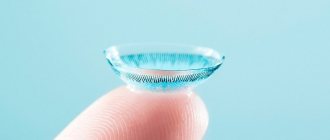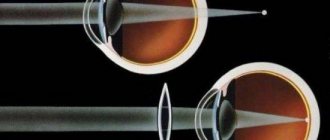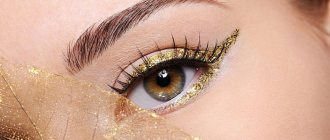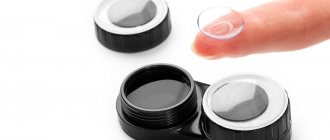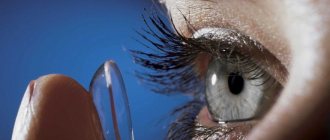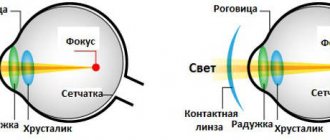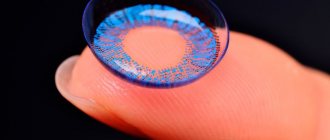Once upon a time, it was possible to correct vision only with ordinary glasses. But about 15 years ago, contact lenses became a part of human life. This is a real salvation for those who are embarrassed to wear glasses or play any sports. Now they have become so familiar and commonplace that you can buy them in almost every supermarket, not to mention specialized retail outlets. But you need to know which lenses to buy. Usually, an ophthalmologist is involved in the selection of these correction agents. But how to choose lenses for your eyes without a doctor? Is it possible?
How to choose lenses for your eyes without a doctor
A little about lenses
- 4.1 Video: Which lenses are suitable for whom?
- 5.1 Video: How to choose lenses?
Nowadays, few people have not seen and do not know what contact lenses look like and what they are. These are small round “bowls”, which, unlike glasses, are put directly on the eyes, which, of course, requires special skill. But on the other hand, they do not interfere with a person’s daily life at all and are not noticeable to others, but at the same time they cope with their task perfectly - they perfectly correct vision.
Contact lenses
Lenses are made from transparent special materials - polymers based on hydrogel or silicone hydrogel. Both of these substances are capable of attracting moisture, which is necessary for the normal functioning of the eyes and is capable of delivering oxygen to the surface of the eyeball. Thus, the eye tissues do not lack oxygen.
On a note! Currently, more than 125 million people around the world use contact vision correction devices. Most of them are young people aged 12-25 years, and the lion's share of them are female.
Comfort of wearing contact lenses
It is interesting that for the first time there was talk of correcting vision using such contact means back in the 1500s. A drawing of a ball of water was found in the works of Leonardo da Vinci. If you look through such a ball, the world around you would be less blurry. The same scientist in his scientific works also had prototype diagrams of means reminiscent of modern lenses. Also, the problem of creating such means of vision correction was dealt with by Rene Descartes, Thomas Jung, and at the end of the 19th century, the German physiologist A. G. E. Fick first described a glass lens that had optical power. Also, the very first lens was developed in 1889, also in Germany, by ophthalmologist A. Muller. He also used lenses to correct myopia.
The history of contact lenses
Until approximately the second half of the twentieth century, lenses were made of plexiglass; they were hard, uncomfortable, got in the way and did not allow the eyes to breathe. But in 1960, a polymer was obtained in the Czech Republic, from which they could make soft lenses that absorbed water. The most pleasant to wear and comfortable lenses - hydrogel - appeared about 10-15 years ago.
Hydrogel lenses are very comfortable
Glasses and frames
Spectacle correction of myopia is preferable for mild to moderate degrees of myopia. As a rule, ophthalmologists prescribe incomplete correction in order to preserve the accommodation reserve. People with myopia of -3 diopters are prescribed several pairs of glasses or bifocal models to provide vision correction at all distances. The lenses in single vision glasses and bifocal glasses are different.
Features of single vision lenses for myopia correction:
- the optical power is the same for the entire area of the lens;
- lenses that correct myopia are thin in the center and thicker at the periphery;
- Traditionally, glasses for myopia correction are made of mineral glass, which have significant weight;
- modern models of glasses are made of lightweight plastic that is resistant to damage;
- The most preferred are polycarbonate lenses (light, durable, stable, and have high refractive indices).
Bifocals provide both near and distance vision. The upper half of the glass in such lenses is intended to correct myopia, and the lower half helps to see near. The difference in optical power between the zones is several diopters, but due to the sharp transition, many people suffer from discomfort.
If you are nearsighted, you can use glasses with multifocal lenses. They, like bifocals, have several optical zones. Their distinctive feature is the presence of a smooth transition between zones, which reduces discomfort when using them. While bifocal lenses provide near and distance vision, multifocal lenses also help you see at intermediate distances. These glasses make it possible to correct both nearsightedness and farsightedness at once.
The most popular are glasses with plastic and metal frames. The type of frame that suits you will depend on the degree of myopia. In the prescription, the doctor indicates the required number of diopters: the stronger the myopia, the thicker the edges of the lenses and, accordingly, the edges of the frame should be.
The plastic frame can accommodate the lenses needed to correct high degrees of myopia. This frame covers the edges of the lens and ensures a tight fit around the perimeter. In addition, the plastic is lightweight, which makes the glasses optimal in weight.
Metal frames are preferable for mild to moderate myopia, when thinner lenses are needed. This is due to the weight of the metal frame, which will cause severe discomfort when combined with thick lenses. People with low myopia can use rimless glasses.
Features of contact lenses
Due to the fact that contact lenses have a lot of advantages, many people with vision problems refuse to wear glasses in favor of them. Benefits of using lenses:
- ease of use;
- the ability to see the world around us undistorted;
- availability;
- invisibility to others;
- impossibility of breakdown;
- no discomfort when entering a warm room from a cool street (in this case, glasses fog up);
- low cost;
- the opportunity not to be embarrassed by visual defects;
- big choice.
Lenses are good because they are invisible to others
However, lenses also have their drawbacks. These are, first of all, difficulties with putting them on, but this drawback can quickly be eliminated simply by mastering the technique of using lenses . They also require special care and can break if handled carelessly. They need to be replaced with new ones regularly, and the period varies from 1 day to several months depending on the type of lenses.
How to put on and remove lenses
Main types of lenses
Nowadays there are a lot of contact lenses on the market. They are produced under different brands and differ in quality, wear time, materials used for production, degree of transparency, etc.
About the types of contact lenses
Table. Types of contact lenses distinguished by ophthalmologists.
| Type | Description |
| Soft | Suitable for those who have minimal problems with eyes and vision, can be used by children as well as adults. There are practically no contraindications for use. They are made from hydrogel or silicone hydrogel. They are worn by most people with vision problems. |
| Hard | Such lenses are used by those who have serious vision problems - high degrees of astigmatism or keratoconus. Very dense and fits well to the eye. Made from polymers. Such lenses can only be used as prescribed by a doctor, otherwise there is a high risk of causing serious harm to health. |
On a note! Contact lenses can even be used to change eye color or create unusual carnival looks. They may not have diopters and are used to achieve some effect.
Colored contact lens
Also, lenses can be day, night or intended for constant wear. Based on the wearing time, the following types of contact correction devices are distinguished:
- one-day;
- weekly;
- period;
- quarterly;
- lenses for six months;
- lenses for a year.
Video: Contact lenses for eyes. Which brand to choose
Tips for choosing
It is not recommended to choose contact lenses on your own, especially if the person has not even worn glasses before. However, this can still be done, but you must adhere to a number of rules.
How to choose contact lenses
It is important to remember that the basic principle of the unauthorized choice of contact lenses is to do no harm! You can’t buy lenses just “for beauty” and as a tribute to fashion (we are not talking about colored lenses). When choosing lenses, you should be guided by the state of your vision, the composition and type of correction products, their expiration date and manufacturer. It is also important to remember that if a person knows exactly the indicators of his vision, then the correction tool should not have the same optical power. It's better to take lenses that are a little weaker.
Advice! When buying lenses yourself, it is better to take those that are worn for only one day. They are usually sold in blisters and do not require special care - you can simply throw them away in the evening after removing them.
When choosing on your own, give preference to daily lenses
Overall, to choose the right contact lenses, you need to remember that they have different characteristics that you should consider. This is the diameter of the lenses, their radius of curvature, thickness and much more.
On a note! Good hydrogel lenses should contain 70% water. Such lenses “breathe” better. Although there are correction products on sale with a water content of less than 50%.
Silicone hydrogel contact lenses
It should also be taken into account that if a person has any eye disease that requires treatment, then it is better not to use lenses. They do not have a therapeutic effect, but can only correct the quality of vision.
Video: Which lenses are suitable for whom?
Does a child with farsightedness need glasses?
Early childhood is characterized by physiological hypermetropia, since the baby’s eyeballs have grown and are not fully formed - they are shorter in the direction of the anteroposterior axis compared to the same indicator in an adult.
Therefore, the focus of the light rays is located somewhat further than necessary, but this phenomenon, firstly, is compensated by accommodation (a change in the curvature of the lens), and secondly, it is reversible: as soon as the eyes grow, the correct relationships between their internal structures will be established.
A peculiar milestone is the age of seven, when a child first goes to school. If at the same time he has an uncorrectable refractive error, the educational process will be significantly complicated, because such a first-grader has poor close-up vision. Even if hypermetropia is compensated by efforts of accommodation, but this happens at the limit of possibilities, problems cannot be avoided: headaches, lacrimation and photophobia will appear, the child will begin to rub his tired eyes with dirty hands, simultaneously introducing an infection there and provoking the development of complications - conjunctivitis, blepharitis, keratitis.
Therefore, if your son or daughter complains of rapid visual fatigue, or you yourself notice corresponding alarming symptoms while your child is still very small and cannot talk about his problem, be sure to contact a pediatric ophthalmologist. This is especially true for children under three years of age with moderate and high degrees of hyperopia - if they are not prescribed glasses for farsightedness in time, they may develop strabismus, and then amblyopia (lazy eye syndrome). In addition, disruption of the outflow of intraocular fluid threatens glaucoma. Dealing with such complications is very difficult.
Thus, if the doctor discovered that your child is farsighted and recommended wearing glasses, you need to listen to his advice and come to the appointment regularly to monitor the changes that are occurring and make timely adjustments to treatment tactics. Surely, parents of children with hypermetropia will be pleased to know that most of these children cease to need optical vision correction in the lower grades of school, and sometimes even before entering school. This is due to the incredible ability of the child’s body to grow and adapt to the conditions of the surrounding world.
How to choose the right glasses for a child with farsightedness?
Here are some important points to consider when choosing children's optics:
Plastic lenses are preferable, although they wear out relatively quickly, become covered with small scratches and become cloudy
But when it comes to accessories for a child, this is not so important, since you will probably have to change them often. It is much more important that the glasses do not break and injure the baby, so it is better to avoid glass lenses; The frame should also be plastic, strong enough and durable, and at the same time beautiful from the point of view of the child himself.
As a rule, parents have much more difficulty motivating their son or daughter to wear glasses than choosing the right lenses. Therefore, be sure to take into account the opinion of the little patient when it comes to the appearance of accessories; The design of children's optics should be as stable as possible. It is unacceptable for glasses to fall off the face, slant to the sides, or dangle on the ears. At the same time, the temples should not dig into the temples and rub the skin, and the bridge should not leave a depressed mark on the nose. That is why it is so important to take careful measurements, carefully examine the frames, invite the child to walk around with glasses for a while, and only after making sure that he is comfortable, make a purchase. If you are worried that your child might drop his glasses during active games, it is permissible to tie a loose elastic band to the temples and secure the accessory around his head, but it is not advisable to do this all the time - properly selected glasses should sit securely on their own.
Video: ideal glasses for a child:
Why it is not advisable to buy lenses yourself
Many people think that choosing lenses is a simple matter. All you have to do is go to the optician and just buy those that will match the dioptres and suit the price. But in reality everything is much more complicated. It is important to consider that the material of lenses may have different elasticity, wearing incorrectly chosen correction products can cause the development of dry eye syndrome, and a person’s eyes can simply reject foreign material. Some people may also be allergic to lenses.
Allergy to contact lenses
Only an ophthalmologist will help you make the most correct choice. It will even take into account a person’s lifestyle, because one-day lenses may be suitable for some, while others can easily cope with wearing those that require quarterly replacement. The doctor will also be able to select the correct lens diameter and advise the company that produces the most suitable option in a particular case.
Video: How to choose lenses?
A vision test by a specialist is the key to correct correction.
You must obtain a prescription before purchasing. Why is this so important? If your vision varies, then you need to accurately determine the parameters of each eye. Otherwise, you will see objects unclearly in incorrectly selected lenses. In addition, incorrect correction can cause harm: it will lead to deterioration of vision, discomfort, and watery eyes.
During the consultation, the doctor will conduct a diagnosis, write a prescription and select optical products in accordance with your parameters. At the same time, wearing comfort is affected not only by the correct selection of diopters and correction of pathologies, but also by the type of lenses and wearing mode.
Benefits of contact correction for eyes with different vision
- In glasses, the tolerable difference between diopters is a maximum of 2-3. That is, for widely varying degrees of correction, it is more difficult to make suitable glasses, they will cost more, and not everyone can wear them. And the lenses have no restrictions: on the right eye it can be +5.0, and on the left -2.0.
- The aesthetic component - with different corrections, the thickness of the lenses on the glasses differs, so it looks unsightly. The thickness of the contact correction means will be the same, and others will definitely not know about the existing problems. This is especially true for a child who may be teased by peers at school.
Fears and risks
In fact, contact lenses are a safe means of vision correction if used wisely. However, many refuse to wear them, even if they really want to learn how to use them. It's all about a number of misconceptions.
For example, some believe that the lens can roll behind the eye and remain there or completely collapse. In fact, this is impossible - the lens is soft and elastic, it simply cannot “break” or in any way damage the eye. And the structure of the eye will not allow it to roll behind him. The maximum that can happen is that the lens gets under the eyelid and prevents the eye from moving normally. But to get rid of it, just pull back the eyelid, and the lens will immediately pop out.
The lens cannot roll behind the eye
Also, a number of people’s fears are associated with the process of putting on and taking off lenses. Many people think that they cannot cope with this task, because they need to practically touch their eyes with their hands. And then, in order to remove the lens, you need to perform extremely complex measures. But they seem difficult only to those who have never done this and have not developed a habit. Even children cope with this task very quickly and after a couple of attempts to put on and remove the lenses, they do it easily.
The myth about the harmfulness and inconvenience of lenses
Advice! To learn how to use lenses easily, you can ask an ophthalmologist for help. He will give useful recommendations, and you can put on lenses for the first time right in his office.
